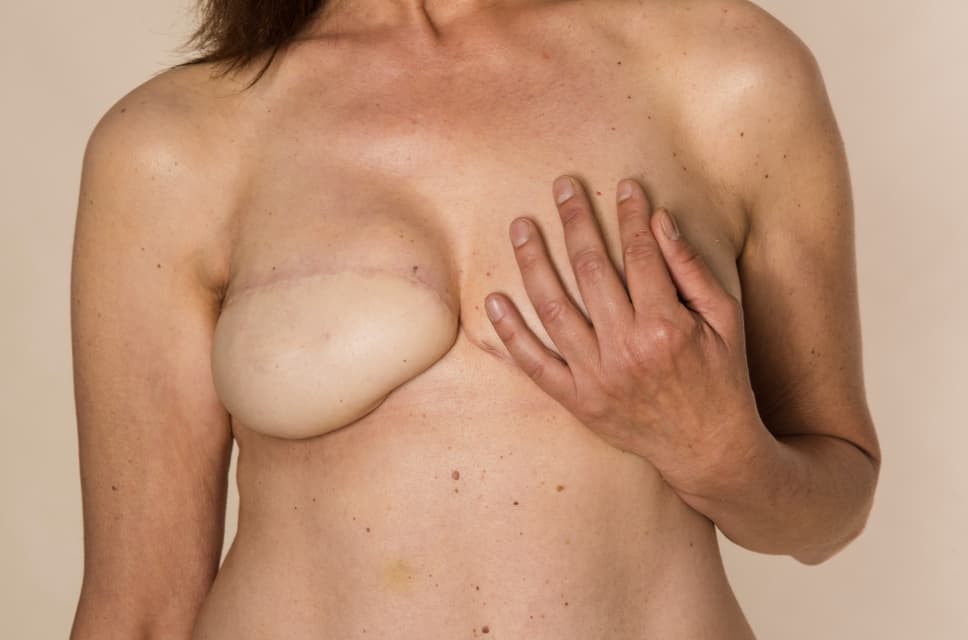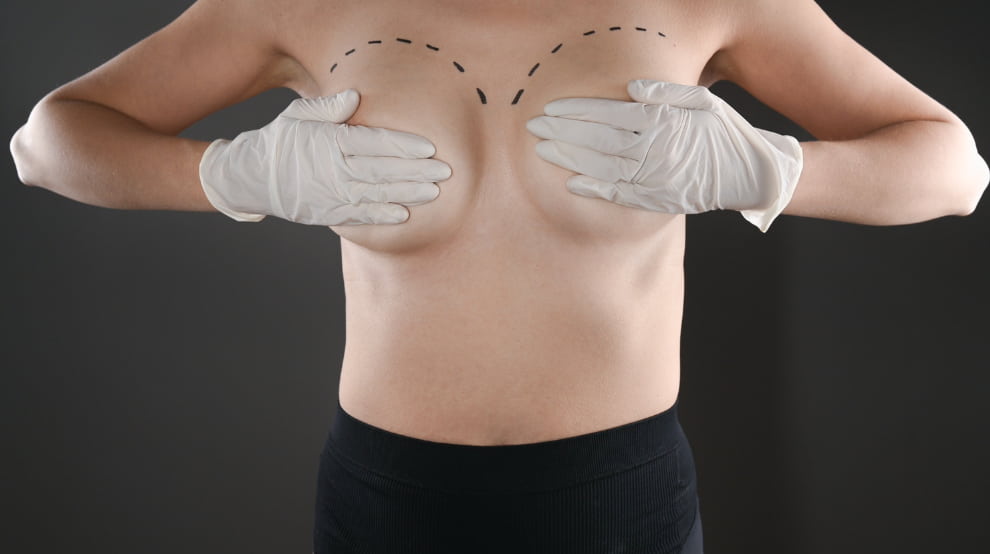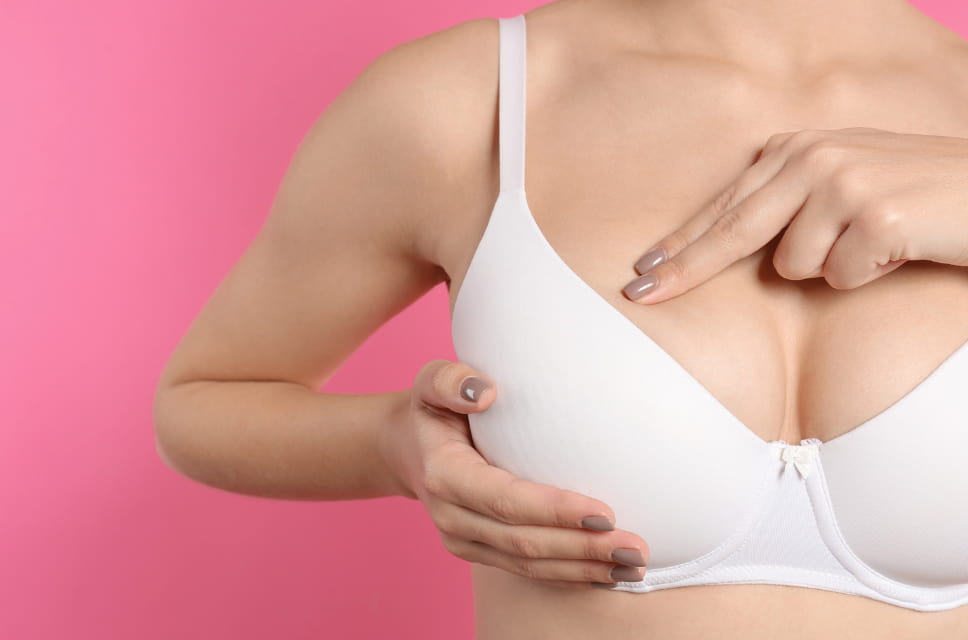Breast reconstruction is a surgical procedure that can be done to recreate one or both breasts after a mastectomy or lumpectomy (partial mastectomy or breast-conserving surgery).
Mainly, there are two ways in which breast reconstruction surgery can be done: using an implant or autologous tissue (tissue taken from a different part of your own body). However, both can also be used in the rebuilding of the breasts. You might also need additional procedures to improve the overall appearance of the breasts.
What Is Breast Reconstruction?
Breast reconstruction is a procedure that involves recreating the breast mounds after breast removal surgery. Depending on when you choose to get this surgery, it has 3 types, as per a 2023 study published in the American Journal of Translational Research:
- Immediate breast reconstruction – When the breast is reconstructed during the mastectomy.
- Delayed breast reconstruction – When the surgery is held off for months or even years after mastectomy – after recovery from radio/chemo’s side effects or when the condition has stabilised.
- Delayed-immediate breast reconstruction – When a tissue expander is placed in the breast during mastectomy to make space for implant or autologous tissue.

There are pros and cons of each procedure, and only your surgeon can best advise you on what will best meet your needs depending on your case. For instance, if you need radiation therapy after mastectomy, your doctor may advise you to delay the breast reconstruction surgery.
It’s because of different things like radiotherapy can increase the risk of infection, delay the healing of the wound, and also affect the final outcome of implant surgery. It may also be more risky for you to have this surgery if you are obese, have diabetes or smoke, which is why your surgeon may advise you to delay.
However, some women also choose to delay this surgery because of other considerations like the costs involved or managing the current diagnosis at hand and taking things one at a time.
Here, it should be noted that getting a breast reconstruction is a choice. Not everyone opts for reconstructive surgery following a mastectomy. Regardless, this decision is deeply personal, and if this is your preference, it’s crucial to communicate it to your doctor.
Who Is A Candidate For Breast Reconstruction?
While you’ll more commonly hear about breast reconstruction with reference to mastectomy, you might also be a suitable candidate for this surgery if you’ve experienced trauma or have a medical condition (like amastia).
In general, you can be a candidate for breast reconstruction if you’re well enough to safely have this procedure and recover from it. But it’s very important to have realistic expectations in mind because it’s highly unlikely that your reconstructed breasts will be the same as your original breasts, so you need to have realistic expectations. For this, you can consider looking at the before and after photos of the previous patients of your surgeon.
Keep in mind that even if it’s been years since your breast cancer surgery and you wish to get your breasts reconstructed, age is not likely to be a barrier. Therefore, make sure to consult a qualified and experienced professional.
How Is Breast Reconstruction Done?
Breast reconstruction can be done using implants, tissue from your own body (autologous breast reconstruction) or both. Here’s a closer look at each:
Breast Reconstruction With Implants
It’s possible to rebuild breasts with the help of implants during mastectomy, however, it can also be a two-step procedure. For this, instead of an implant, your surgeon will place a tissue expander to make space for the implant itself.

Over time, fluid is injected into this expander using a needle to gradually stretch the skin. It can be months before the expander is replaced by an implant. Keep in mind that if you’re only getting surgery on one of your breasts, your surgeon may advise surgery on the other breast as well to achieve breast symmetry.
It’s also important to note that, like every surgery, this one also comes with certain risks, such as implant rupture, capsular contracture, infection, etc. Make sure to discuss these with your doctor so you can make a more informed decision.
Autologous Breast Reconstruction
Autologous breast reconstruction is done with the help of tissue taken from a different area of your body. These pieces of tissue or flaps can be of two types: free or pedicled.
Free is when they’re cut off from their original blood supply and reattached to a new one, and pedicled is when the original blood supply is still intact, so there’s no need for reattachment. Both types of flap surgeries are used in autologous breast reconstruction, which can be done as follows:
- TRAM (transverse rectus abdominis myocutaneous) flap – This could be free or pedicled; the tissue is taken from the abdomen to the chest.
- DIEP (deep inferior epigastric perforator) flap – It’s a free flap surgery in which just skin and fat (not muscle) are taken from the abdomen to the chest.
- SIEA (superficial inferior epigastric artery) flap – It’s a free flap taken from the abdomen; only skin and fat are taken, not the muscles.
- LD (latissimus dorsi) flap – It’s pedicled with muscle, skin and fat tissue taken from the back. It may be done together with an implant.
- TAP/TDAP (thoracodorsal artery perforator) flap – It’s pedicled and taken from the same area as the LD flap in the back.
This list is not exhaustive, and flaps for this type of reconstruction can also be taken from buttocks, thighs, hips and the breast itself. Other than that, lipofilling can also be done, where fat removed from one area of the body, using liposuction, can be transferred to another.

Your surgeon will advise you on the surgical technique that can best meet your needs depending on the tissue available in the different areas of your body, the condition of your breasts, aesthetic goals, etc. It’s important to discuss everything thoroughly with them, along with the potential complications of these surgeries, which may include things like the death of the flap tissue, scarring, etc.
Nipple And Areola Reconstruction
Your mastectomy surgery may involve the removal of the nipples, however, you may possibly get them reconstructed after your breast surgery. The nipple might be created from the skin of the new breast and then tattooed to create the illusion of a real nipple.

The areola can also be reconstructed using a skin graft followed by tattooing. However, if nipple and areola reconstruction surgery is not an option for you, a 3D tattoo can be another alternative, but this is something you should further discuss with your surgeon.
How Long Does It Take To Recover From Breast Reconstruction?
Recovery from breast reconstruction surgery can take somewhere between 1.5 to 3 months. It can vary depending on the type of procedure you have (for instance, it might be shorter for implant surgery compared to an autologous tissue procedure).
Your doctor will quite likely prescribe you medications to deal with the post-op side effects, and you might be fitted with surgical drains as well. Since the aftercare instructions can vary between patients and surgeons, you must consult your doctor for any post-operative query.
What Do Reconstructed Breasts Feel Like?
Unfortunately, your reconstructed breasts will not feel the same as your original breasts. According to Breast Cancer Now, you are likely to experience “loss of sensation” in your new breasts along with sites of scarring. Additionally, you can have numbness/pins and needles and the numbness, for many women, is permanent.

You might not always lose sensation, as according to Yale Medicine, it’s “unpredictable” and can be partially influenced by whether or not the skin, nipple and areola were spared during the mastectomy.
How Much Does It Cost For Breast Reconstruction?
According to the British Association of Plastic, Reconstructive and Aesthetic Surgeons (BAPRAS), you can get free breast reconstruction surgery on the NHS. This type of surgery is also usually covered by insurance, but you may still have to end up paying a significant sum.
For this reason, it can be helpful to not only talk to your surgeon but also to the health insurance company and a “financial navigator” to get maximum coverage with minimal cost to you, as per Breast Cancer.org.
The cost of the breast reconstruction procedure will vary depending on what you’re getting done. According to a report by Breast Cancer Now, the long-term cost for the two breast reconstruction procedures is as follows:
- With implants – £10,180
- With free flaps – £10,779
If you’re also getting additional procedures like nipple and areola construction, it will also affect the overall cost, along with the location of the clinic and the experience of the medical team in case you’re going private.
Conclusion
Breast reconstruction surgery can help rebuild your breasts in a way that can create a feeling of wholeness. While you may have the option to have the surgery during the mastectomy, you can also wait to have this surgery at a time you feel will be better for you.
This type of plastic surgery is also available on the NHS and likely to be covered by insurance, although you should make sure to have consultations with all the relevant people. And if you’re considering getting this surgery privately, make sure you find a board-certified and experienced medical professional.
Reviewed and approved by Prof. Dr. Fuat Yuksel
FAQ
Can a reconstructed breast get cancer?
It’s possible for you to get cancer after breast reconstruction surgery. However, according to BAPRAS, based on current evidence, breast reconstruction during or after the treatment of cancer does not “increase the chances of the cancer recurring.” Still, you must discuss this concern with your doctor beforehand.
Can belly fat be used for breast reconstruction?
Autologous breast reconstruction may be done using tissue, which can include fat from the abdomen. However, not everyone is suitable for this surgical technique.
How long after radiotherapy can you have breast reconstruction?
Since radiotherapy can affect the outcome of breast reconstruction with implants, you may be advised to wait until the treatment is completed and you’ve recovered from the side effects. It can be quite a few months, but only your surgeon can best guide you on this.
Is breast reconstruction painful?
You’re going to be under anaesthesia for your breast reconstruction surgery, so it shouldn’t be painful. For pain afterwards, your surgeon will likely prescribe you medication to manage the pain. However, in case you feel it’s worsening or persisting, you should consult your surgeon immediately.

